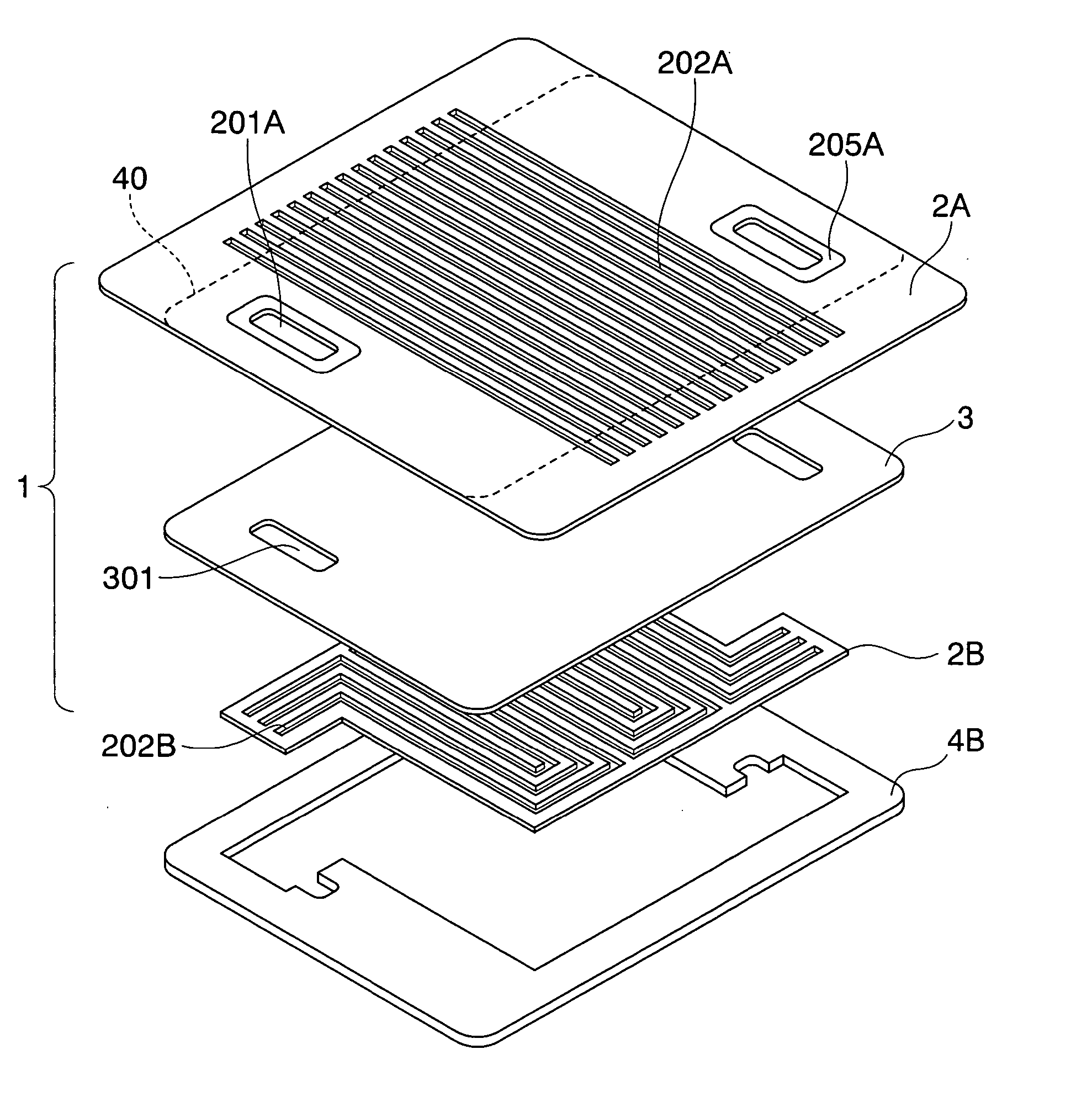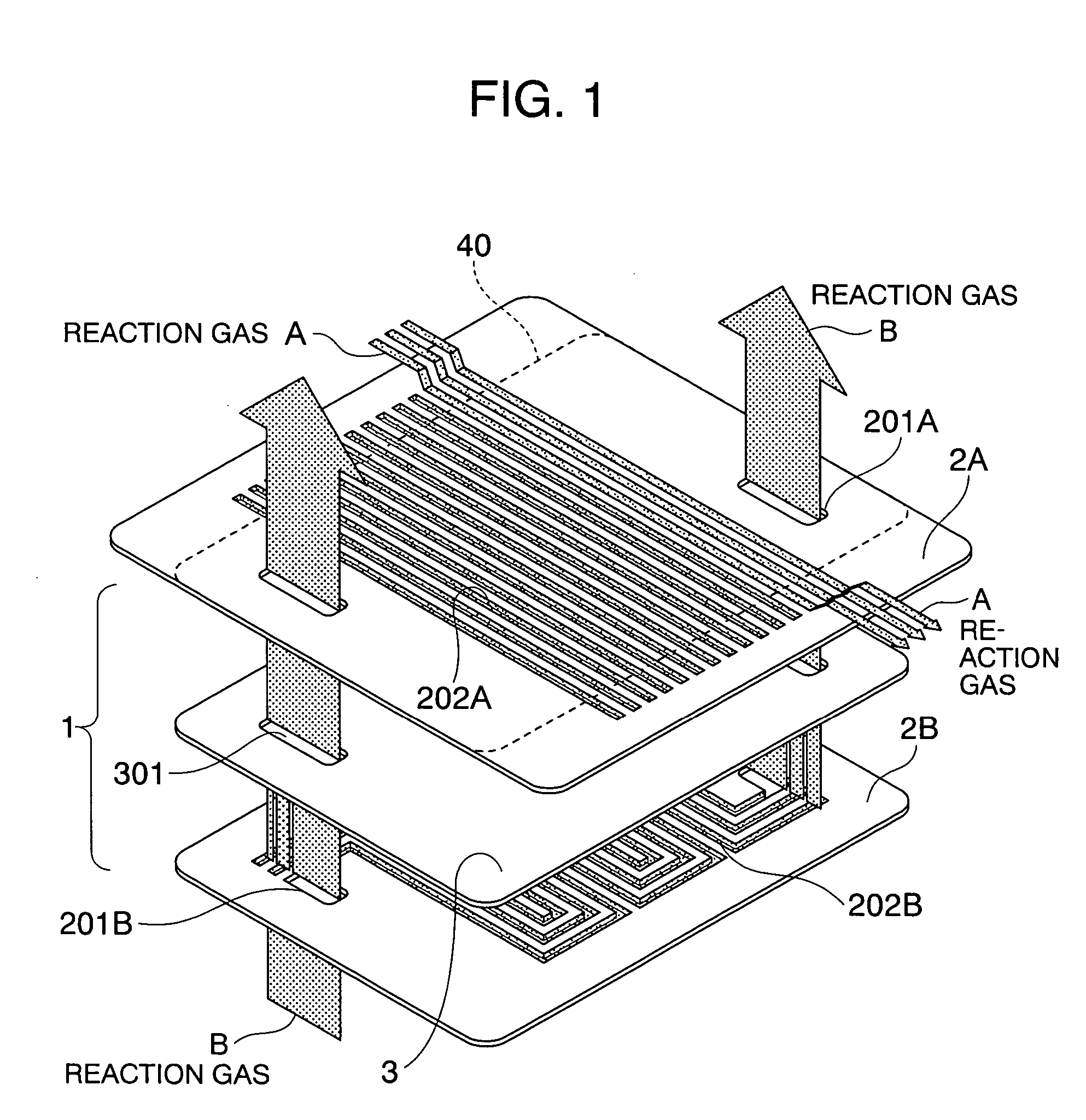Separator for fuel cell and fuel cell using it
a fuel cell and separator technology, applied in the direction of cell components, cell component details, electrochemical generators, etc., can solve the problems of insufficient contact area with the electrode, difficult to provide the desired power-generating performance, and difficulty in forming a channel having a desired depth and a desired width, etc., to achieve the effect of reducing cost, reducing cost, and prolonging li
- Summary
- Abstract
- Description
- Claims
- Application Information
AI Technical Summary
Benefits of technology
Problems solved by technology
Method used
Image
Examples
embodiment 1
[0051]FIG. 1 shows the basic arrangement of a separator according to the present invention. The separator 1 in the present embodiment is comprised of a coated metal plate 3 and electrically conductive channel plates 2A and 2B. The coated metal plate 3 is formed by forming a corrosion-preventing coating layer on a flat plate-shaped metallic substrate. A plurality of manifolds 301 for passing a reaction fluid to an adjacent cell are formed in the coated metal plate. A plurality of serpentined through-channels 202B are provided in the channel plate 2B, and a plurality of manifolds 201B, as required, are formed in the channel plate 2B. A plurality of straight through-channels 202A are provided in the other channel plate 2A, and a plurality of manifolds 201A, as required, are formed in the channel plate 2A. The sizes of the coated metallic plate 3 and the channel plate 2B are equal or substantially equal to each other, but the size of the channel plate 2A is larger than those of the coat...
embodiment 2
[0062] An example in which each of channel plates 2A and 2B is a porous member will be described below with reference to FIG. 5. If each of the channel plates 2A and 2B is the porous member, the amount of gas supplied to the electrode through the channel plates is increased and hence, there is an effect of increasing a generated voltage and a diffusion-limited current. FIG. 5 is a view showing a separator 1 made using channel plates 2A and 2B which are porous members. Because the channel plates 2A and 2B are the porous members, a reaction gas is freely movable in the porous member. For this reason, a single channel plate 2 as described in Embodiment 1 cannot be used.
[0063] In this embodiment, a gasket 4B is disposed around the channel plate 2B, and sealing portions 205A are provided around the manifolds 201A in the channel plate 2A. Thus, it is possible to suppress the cross leakage of the reaction gas from an anode to a cathode and from the cathode to the anode, the leakage of the...
embodiment 3
[0066] An example including a coated metallic plate 3 provided with slits will be described with reference to FIGS. 7 to 9. FIG. 7 shows a separator 1 including the coated metallic plate 3 provided with the slits. The basic structure of the separator is the same as that described in Embodiment 1, except that the coated metallic plate is different. The positions of the slits 310 provided in the coated metallic plate 3 are determined so that through-channels 202A and 202B in a surface corresponding to an electrode are overlapped with each other upon superposition of a channel plate 2A and a channel plate 2B on each other. Such a situation is shown inFIG. 8.
[0067] A diagram of the two channel plates 2A and 2B superposed on each other is shown at a right and upper portion of FIG. 8, and a diagram of the coated metallic plate 3 provided with the slits 310 is shown at a left and lower portion of FIG. 8. FIG. 8 is a figure for convenience of the description, and the actual positional rela...
PUM
| Property | Measurement | Unit |
|---|---|---|
| area | aaaaa | aaaaa |
| depth | aaaaa | aaaaa |
| depth | aaaaa | aaaaa |
Abstract
Description
Claims
Application Information
 Login to View More
Login to View More - R&D
- Intellectual Property
- Life Sciences
- Materials
- Tech Scout
- Unparalleled Data Quality
- Higher Quality Content
- 60% Fewer Hallucinations
Browse by: Latest US Patents, China's latest patents, Technical Efficacy Thesaurus, Application Domain, Technology Topic, Popular Technical Reports.
© 2025 PatSnap. All rights reserved.Legal|Privacy policy|Modern Slavery Act Transparency Statement|Sitemap|About US| Contact US: help@patsnap.com



